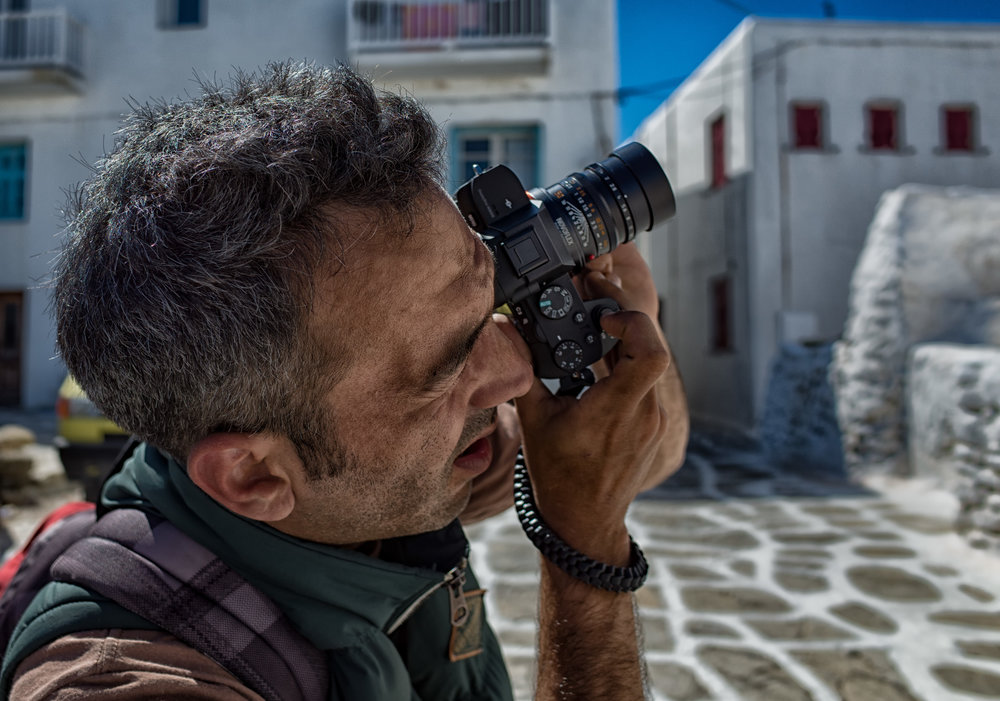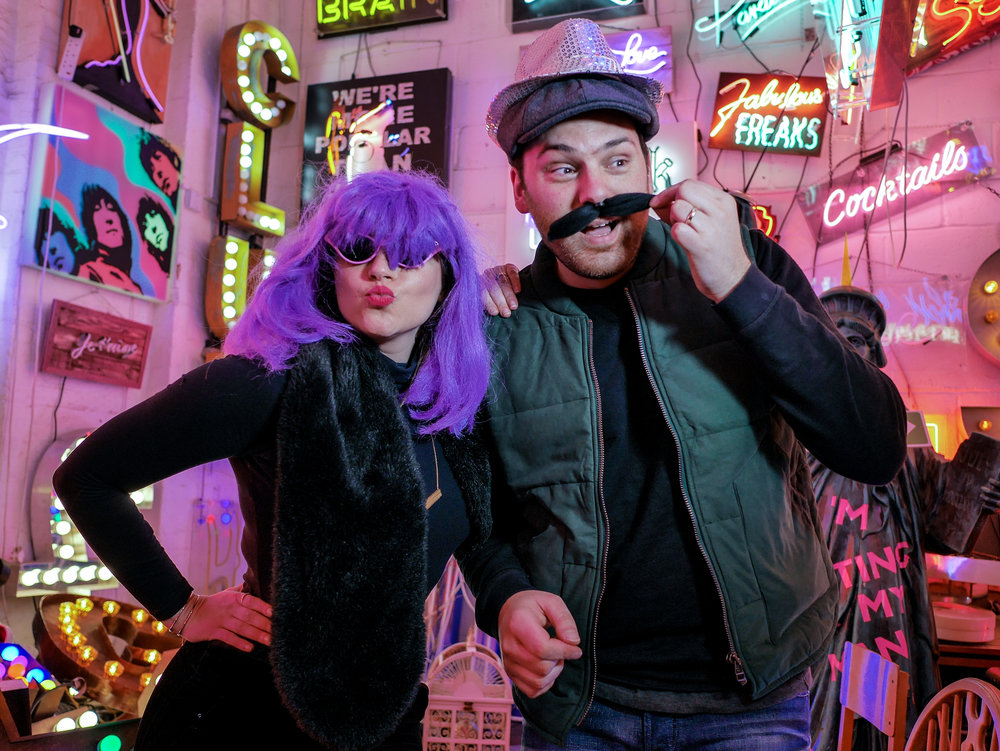
With the universal popularity of smartphone photography there is a whole generation of snappers content to compose on a screen instead of peering through a viewfinder. Yet for photographers brought up on viewfinders it is hard to see the benefits of screen composition. Many cringe at the thought of holding a camera at arm’s length.
I’m a great fan of viewfinders and have often said I wouldn’t buy another camera without either an optical or electronic finder built into the body. I’m not entirely true to my convictions because I do own three little cameras without built-in finders — the trusty old Leica X1, the Ricoh GR and a recent acquisition — by chance as it happens — the Panasonic Lumix GM1.
I can fit optical finders to both the Leica and the Ricoh, but the little m4/3 GM1 — which I will be covering in more detail soon — has no accessory shoe, therefore no opportunity to fix a finder. Since I’ve been using the GM1, therefore, I have been forced to compose exclusively with the screen. I am getting used to it and beginning to see some benefits.

One-cam Eric
Eric Kim is already sold on the idea of composition by screen as he outlines in this article. He lists a number of advantages of screen-only shooting.
He believes it helps with creativity and it helps him get closer to the subject without scaring the horses; the absence of a viewfinder means the camera body can be smaller and helps Eric take his photography less seriously.
The important point to take from this is that screen composition is more casual, more smartphoney and consequently less threatening. A photographer with the extremely competent Ricoh GR, for instance, will be seen as an amateur, a tourist even, and can harvest candid shots that might otherwise frighten off or annoy more sensitive subjects.
Heresy
I can see lots of merit in this argument. For small pocket cameras such as the GR, the Sony RX100 or the Panasonic GM1, I can manage without a viewfinder. Once upon a time I would have regarded this as heresy of the first order; but now I accept that I can often get closer and take more candid shots than would be the case if I were squinting through the viewfinder of a Leica M or, even worse, an SL or pro DSLR.

This argument can run and run. Some photographers wouldn’t look at a camera without a viewfinder and spend considerable time looking down their noses at smartphone users and tourists with their point-and-shoot cameras. Others take a more pragmatic view and accept that there are occasions when an ultra-small camera can be more effective when used via the screen.
Are you a die-hard viewfinder person or do you agree with Eric’s strident views on screen composition? Discuss.
_________________

A supplementary comment, which will certainly matter to some: Since the Clear Viewer is using the screen, it is in effect looking through the lens, so there is no parallax error. If I had a Ricoh GR, Mike, I would certainly buy one for it. I like it very much on my X1. Somehow it also seems to preserve the feel of the camera’s own dimensions. I should mention that the view has a noticeable but not in any way intrusive "raster" effect on the screen image.
Thanks, John, it would be worth buying just to make a story. I will investigate.
Thank you for the reference to Ric Kim’s article – very instructive.
Now, on VF contra screen, there is a third way, and I’m surprised so few people seem to have come across it. It is called a "ClearViewer" (clearviewer.com). It is basically a cllapsible loupe without the surrounding casing, and that allows it to be mounted on the tripod hole and collapse flat against the screen when not in use. I offers all the benefits of the screen full size including whatever information your screen also displays. You hold it to your eye so that the short bottom arm which supports the upright viewing lens rests on the top of your cheek-bone and gives you something of the extra steadying you get from holding the camera right up to your eye with an OVF or EVF. I’ve used it with several of my cameras and can’t recommend it too highly. (And I don’t get commission!)
John, I know you’ve mentioned this before. I really ought to get one to try on the Ricoh and Panasonic GM1.
http://clearviewer.com/socket.html
I recently traveled with a Fuji X-Pro2 mini-system. That gives me three VFs. On a previous trip of a similar nature, I took a Fuji X100 and Ricoh GR. Similar VF combinations but with another footprint option. When I review my photos of the most recent trip, something is missing; it’s the great unassuming candid images from the GR.
For this recent trip, I managed to convince myself to leave the GR at home because of the difficulty of using the LCD VF in the full-time full sun in the USA desert southwest. Yet I managed to get good images with the GR in Rome, certainly the sun shines there.
What made the full sun photos in Rome possible was the great snap-shot (quick shutter press) capability of the GR, close distance and no framing at all. Just pick a direction and shoot. I probably looked like a pro doing that because amatures and toddlers certainly have better technique.
For critical framing, in the full-sun climates where I often find myself, the LCD only option can be difficult. The same goes for my iPhone 6. With more pixels, the resultant crops are more than enough for social media and scrapbooks – stuff of most memory books. So what’s difficult for me is this notion of discrete photography where, anything goes, throw away the unwanted portions, relax your perfectionist criteria, know that you are operating in this mode and just do it. Critical is not a requirement of discrete.
My situation is that my family/travel commitments and discrete often clash. Rarely do I set off to do discrete photography. So whatever fills that role in my kit needs to be there all the time, a discrete option possibly more important than that extra lens. It has less to do with VF choice, than recognizing the "mission".
Perhaps in this new age of digital images and social media, discrete photography is the mainstay and this equipment laden critical approach is the thing I need to let go.
All very sensible advice, Roger. It seems everyone has a Ricoh GR tucked away somewhere about their person (or, at least, most people who read Macfilos). I agree that when it comes to discreet photography the Ricoh is the perfect choice.
Meyer Megoflex (just ‘google’ it). Pop it on your 1920s 1 Model A Leica and away you go.
William
I love my Leica M-D and M Monochrom with their fast lenses, but out on the street in good light NOTHING beats my little Leica X-E, usually at f/5.6 or f/8 and zone focused at two meters.
Andrew, I think we are singing from the same hymn sheet…..
While on the subject of discreet photography let’s not forget the benefits of shooting from the hip. Much as I love the M viewfinder, I so often find myself street-strolling with a 28mm at waist level!
Agreed….. But a tilting screen does help, as does the Visoflex. On the other hand, as you say, a wide-angle lens allows you to shoot from the hip and not worry too much about framing.
It is not that I mind framing my pictures in a screen, and sometimes I even prefer doing it (e.g., when taking pictures of objects, indoors, or when taking pictures from low angles). But the screen has two very important drawbacks, which seem to be ignored by most people commenting on the subject: (1) in a country like Portugal it is usually hard to see the screen during the daytime, and (2) when you are shortsighted – I am – the screen forces you to look at the screen with reading glasses, and the scene without. With a viewfinder plus diopter correction I do it all without the hassle of putting on and taking off my glasses all the time. The ideal solution? A very good and large viewfinder AND a folding screen. Using one or other depending on the circumstances.
You make a good point, Luis. The sun has been known to come out here in London and I agree that screens can be difficult to see. Another thing is that they use more power — the M rangefinder without use of the screen (especially the M-D — is very frugal on batteries. Once you switch on live view this all changes.
I suppose I have never had a problem with "screen" composition. Use of my Rolleichord and Semflex TLR – not to mention Hasseblad camera- is a great joy. The problem resides in holding the camera away from your body. It has distinct disadvantages that cannot be ignored, e.g. stability. I know Apple will never introduce it on the IPhone; but if they did make a model available with tilt screen, I would pre-order…………………I never pre-order.
Maybe the same thing could be accomplished by some sort of high-quality, small clip on device using mirrors to redirect the lens.
Wide angle lens, 45 degree-angled screen, camera held at waist level slightly away from body.
A camera, ANY camera these days = trouble….the ONLY way to perform street photography is with a phone…and even that is getting more difficult…cameras are dying a slow but sure death. Also…owning a camera automatically means you have money…and targets you for crime, or beggars, or hustlers trying to sell their junk. I spent a month in Morocco recently…even showing a camera in public is more trouble that anyone can imagine.
if you wish to perform street photography with a camera, you must have a 100% quiet shutter, a flip screen, and you need to get really good at pretending like you are viewing old images…also a manual lens is best…I love my Samyang 12mm on the Sony….hyperfocal focusing is the only way to go…you have no time anymore to compose, focus etc…and autofocus is a joke
It seems to me that some manufacturers can manage to fit one to the smallest of camera… The latest Sony Rx100, the Panaleica LX100…
In my view, the viewfinder is paramount… The rear display is a handy tool for many things along with the occasional composition, but I would rather keep the viewfinder than the display.
So in my view, Leica got it right when they jettisoned the screen on the MD, pity about the baby that went out with the bathwater though.
I am unlikely to buy an M4/3 camera, but I really like the way that Panasonic have implemented the EVF in their GX8, I had a similar set up with the XE-2, and I found the variable angle very useful. Unfortunately the accessory method is ultimately unacceptable (unless on an M), so the XE-2 went.
I was really hoping that the Leica T (version 2) would have one built in, disappointing for what is potentially a great system.